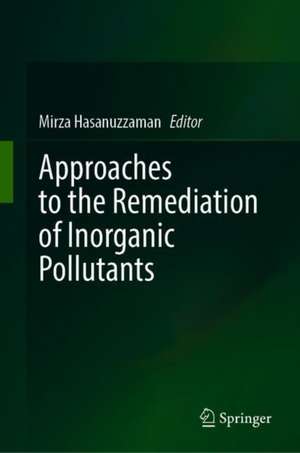Approaches to the Remediation of Inorganic Pollutants
Editat de Mirza Hasanuzzamanen Limba Engleză Hardback – 9 feb 2021
| Toate formatele și edițiile | Preț | Express |
|---|---|---|
| Paperback (1) | 1045.49 lei 38-44 zile | |
| Springer Nature Singapore – 10 feb 2022 | 1045.49 lei 38-44 zile | |
| Hardback (1) | 1052.02 lei 38-44 zile | |
| Springer Nature Singapore – 9 feb 2021 | 1052.02 lei 38-44 zile |
Preț: 1052.02 lei
Preț vechi: 1384.24 lei
-24% Nou
Puncte Express: 1578
Preț estimativ în valută:
201.31€ • 210.71$ • 167.55£
201.31€ • 210.71$ • 167.55£
Carte tipărită la comandă
Livrare economică 26 martie-01 aprilie
Preluare comenzi: 021 569.72.76
Specificații
ISBN-13: 9789811562204
ISBN-10: 9811562202
Pagini: 403
Ilustrații: XIX, 403 p. 34 illus., 30 illus. in color.
Dimensiuni: 155 x 235 mm
Greutate: 0.68 kg
Ediția:1st ed. 2021
Editura: Springer Nature Singapore
Colecția Springer
Locul publicării:Singapore, Singapore
ISBN-10: 9811562202
Pagini: 403
Ilustrații: XIX, 403 p. 34 illus., 30 illus. in color.
Dimensiuni: 155 x 235 mm
Greutate: 0.68 kg
Ediția:1st ed. 2021
Editura: Springer Nature Singapore
Colecția Springer
Locul publicării:Singapore, Singapore
Cuprins
Chapter 1. Ion homeostasis and its role in salt remediation by halophytes.- Chapter 2. Role of Transporters in Accumulating Salt Ions by Halophytes.- Chapter 3. Dual Role of Nitrogen: Essential Plant Mineral Element and Source of Inorganic Pollution.- Chapter 4. Synthesis and regulation of secondary metabolites in plants in conferring tolerance to toxic metals and inorganic pollutants.- Chapter 5. Bicarbonate toxicity and elevated pH in plants: Metabolism, regulation and tolerance.- Chapter 6. Antioxidant defense systems and remediation of metal toxicity in plants.- Chapter 7. Current Research on the Role of Plant Primary and Secondary Metabolites in Response to Cadmium Stress.- Chapter 8. The current scenario and prospects of immobilization remediation technique for the management of heavy metals contaminated soils.- Chapter 9. Inhibition of donor and acceptor side of Photosystem II by cadmium ions.- Chapter 10. Physiological and Molecular Mechanism of Metalloid Tolerance in Plants.- Chapter 11. Heavy metals-induced morphophysiological and biochemical changes in Mentha piperita L..- Chapter 12. Heavy Metals-induced Physiological and Biochemical changes in Fenugreek (Trigonella foenum-graceum L.).- Chapter 13. Copper-induced responses in different plant species.- Chapter 14. Concept and types of phytoremediation.- Chapter 15. Bioremediation of Heavy Metals Using the Symbiosis Between Leguminous Plants and Genetically Engineered Rhizobia.- Chapter 16. Metallothionein- and Phytochelatin-assisted mechanism of heavy metal detoxification in microalgae.- Chapter 17. Efficacy of Duckweeds for phytoremediation: Morpho-physiological and biochemical alterations.- Chapter 18. Metals Phytoextraction by Brassica species.- Chapter 19. Molecular Basis of Plant-Microbes Interaction in Remediating Metals and Inorganic Pollutants.
Notă biografică
Dr. Mirza Hasanuzzaman is a Professor of Agronomy at Sher-e-Bangla Agricultural University, Dhaka, Bangladesh. He received his PhD on ‘Plant Stress Physiology and Antioxidant Metabolism’ from the United Graduate School of Agricultural Sciences, Ehime University, Japan with a Japanese Government (MEXT) scholarship. Later, he completed his postdoctoral research at the Center of Molecular Biosciences (COMB), University of the Ryukyus, Okinawa, Japan on a Japan Society for the Promotion of Science (JSPS) postdoctoral fellowship.
Subsequently, he served as an Adjunct Senior Researcher at the University of Tasmania on an Endeavour Research Fellowship from the Australian Government. Prof. Hasanuzzaman has been engaged in research in the field of Crop Science, especially focusing on Environmental Stress Physiology, since 2004. He has published over 100 articles in peer-reviewed journals and books, edited 13 books and written 35 book chapters on various aspects of plant physiology, plant stress responses, and environmental problems in relation to plant species. He is an Editor or Reviewer for more than 50 peer-reviewed international journals and received the Publons Global Peer Review Award in 2017, 2018 and 2019. He has been honored for his outstanding performance in different fields like research and education by various authorities and received e.g. the World Academy of Science (TWAS) Young Scientist Award in 2014.
Subsequently, he served as an Adjunct Senior Researcher at the University of Tasmania on an Endeavour Research Fellowship from the Australian Government. Prof. Hasanuzzaman has been engaged in research in the field of Crop Science, especially focusing on Environmental Stress Physiology, since 2004. He has published over 100 articles in peer-reviewed journals and books, edited 13 books and written 35 book chapters on various aspects of plant physiology, plant stress responses, and environmental problems in relation to plant species. He is an Editor or Reviewer for more than 50 peer-reviewed international journals and received the Publons Global Peer Review Award in 2017, 2018 and 2019. He has been honored for his outstanding performance in different fields like research and education by various authorities and received e.g. the World Academy of Science (TWAS) Young Scientist Award in 2014.
Textul de pe ultima copertă
In this comprehensive book, plant biologists and environmental scientists present the latest information on different approaches to the remediation of inorganic pollutants. Highlighting remediation techniques for a broad range of pollutants, the book offers a timely compilation to help readers understand injury and tolerance mechanisms, and the subsequent improvements that can be achieved by plant-based remediation. Gathering contributions by respected experts in the field, the book represents a valuable asset for students and researchers, particularly plant physiologists, environmental scientists, biotechnologists, botanists, soil chemists and agronomists.
Caracteristici
Highlights the mechanisms of plants’ tolerance to inorganic pollutants and various approaches to remediation Compiles the latest information on remediation approaches from the literature Presents relevant information for application in the field
